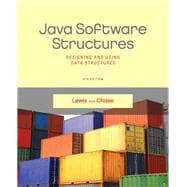The fourth edition of Java Software Structuresembraces the enhancements of the latest version of Java, where all structures and collections are based on generics. The framework of the text walks the reader through three main areas: conceptualization, explanation, and implementation, allowing for a consistent and coherent introduction to data structures. Readers will learn how to develop high-quality software systems using well-designed collections and algorithms.










